This article was published as a part of the Data Science Blogathon
Introduction:
Pandas is a library generally used for data manipulation and data analysis. Pandas is used to handle tabular data. In particular, it provides the data structure as well as functionality for managing numerical tables and time series. The name ‘Pandas’ is derived from the term “panel data”, which means an econometrics term for data sets. One shall use Pandas heavily for data manipulation, visualization, building machine learning models, etc. There are two sorts of data structures in Pandas –
- Series
- Dataframes.
Installing Pandas:
Installing pandas using the following command on the conda command prompt.
(base)$ source virtualenv_name/bin/activate
(virtualenv_name) $ pip install pandas
Getting Started with Pandas:
Once Pandas is successfully installed in your system, you can import Pandas simply by,
import pandas as pd
where pd is an alias used for Pandas so that the Pandas package can be referred to as pd instead of pandas.
Creating Pandas Series:
# A pandas series pd.Series( [ 12, 13, 1, 3, 5 ] )
# A pandas series with explicit indexing pd.Series( [ 2, 4, 6], index = [ 'ad', 'bd', 'cd' ] )

Creating Pandas Dataframe:
# A pandas dataframe
pd.DataFrame({'name': ['Akash', 'Shivam', 'Neil', 'Manish'], 'age': [21, 23, 24, 28],'occupation': ['data scientist', 'doctor', 'data analyst', 'engineer']})
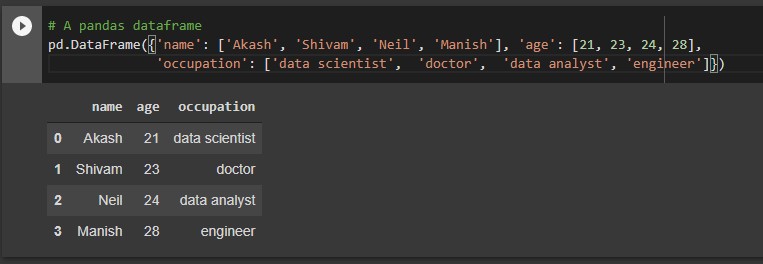
Sorting in Pandas:
The below code will set the specified column as an index of the dataframe.
# setting a column as index
df.set_index('col_name' , inplace = True)
The below code will sort the dataframe
# sorting the dataframe by index df.sort_index(axis = 0, ascending = False)
The below code will sort the dataframe based on column values specified.
# sorting the data frame by a column df.sort_values(by = 'col_name', ascending = False)
Inspection of Dataframe:
The below code will return the total number of rows and columns as a tuple.
#Checking the shape of a dataframe df.shape
dataframe.head(n): This function will return the first n rows of the data frame. By default, it gives the first 5 rows if n is not given explicitly.
#Viewing top 5 rows of the data frame df.head() #One can view any number of top rows by df.head(3) df.head(15)
dataframe.tail(n): This function will return the last n rows of the data frame. By default, it gives the last 5 rows if n is not given explicitly.
#viewing bottom 5 rows df.tail() #One can view any number of bottom number df.tail(10)
dataframe.info(): This method prints all the information about a DataFrame which includes the index dtype and columns, non-null values for each column, and memory usage for the overall data frame.
Let’s check the info for the dataframe that we created earlier
# metadata summary df.info()
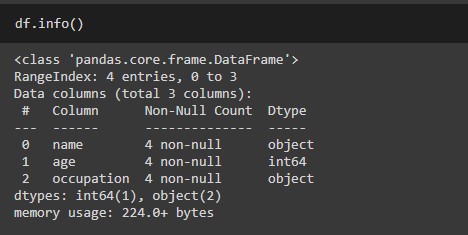
dataframe.describe() includes Descriptive statistics includes summary like central tendency, min, max, and shape of a dataset’s distribution, excluding null values for the numerical column. And summary like count, frequency, etc for categorical columns.
Let’s check the output of this function for the data frame we created earlier.
# statistical summary df.describe()
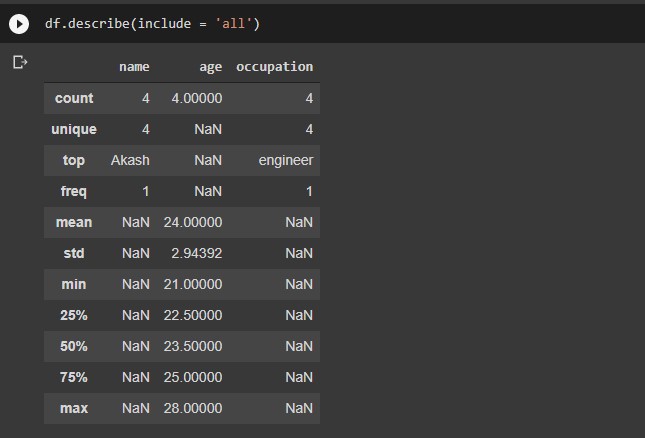
#Returns the memory consumed by columns df.memory_usage()
#Returns the columns of the data frame as a array df.columns
#Returns the values as an array data.values
Extracting columns in Pandas:
# Extract a specific column as a series df[ 'col_name' ] df.col_name
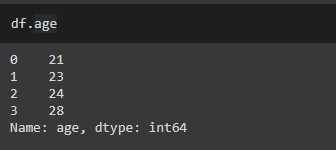
#Extracting multiple columns at a time df[ [ 'col_1', 'col_2', 'col_3' ] ]
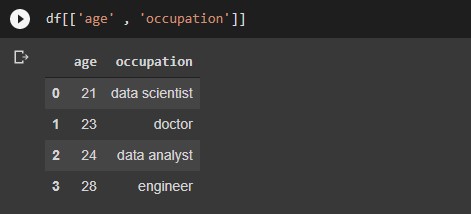
Let’s define a data frame so that we can implement the following codes
df = pd.DataFrame( {
'Name' : ['Neil', 'Aishwarya', 'Rahul', 'Shivani','Namrata','Pawan', 'Karan','Krish'],
'Age' : [23, 21, 22, 21, 20, 22, 22, 23],
'University' : ['BHU', 'JNU', 'DU', 'BHU', 'IIT', 'MU', 'JNU', 'MU'],
'Specialization' : ['Mathematics' , 'Biology', 'Physics' , 'Chemistry', 'Accountancy', 'Mathematics', 'Bio-Chemistry', 'Astrophysics']

Index-based slicing:
# Extracting a particular column and row from dataframe. dataframe.iloc[m,n] where m is row index and n is column index df.iloc[3, 5] # single element 4throw and 6th column
Output:

#Extracting a specific row with all columns df.iloc[5, :] # single row and all columns
Output:

#Extracting multiple rows at a time by providing list of indices df.iloc[ [2, 5, 7] ] df.iloc[ [2, 5, 7] , : ] df.iloc[ [2, 5, 7] , ]
Output:
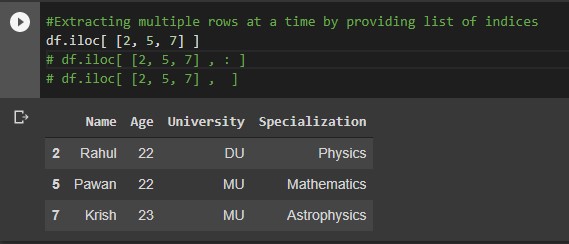
#Extracting particular range of rows df.iloc[2 : 8] df.iloc[2 : 8 , : ] df.iloc[2 : 8 , ]
Output:
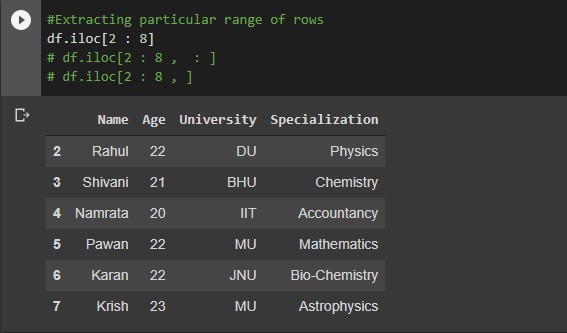
#Extracting a particular column by index number df.iloc[ : , 2 ]
Output:

#Extracting particular range of columns df.iloc[ : , 1 : 3 ]
Output:
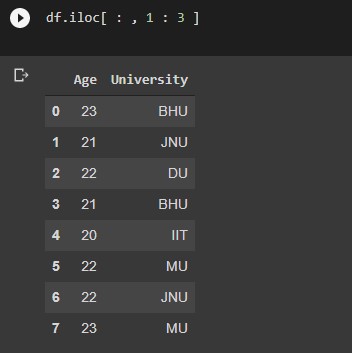
#Extracting rows and columns of a particular range df.iloc[ 3 : 6 , 1 : 3 ]
Output:
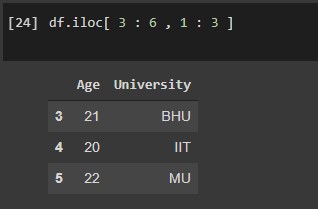
Label based slicing:
#Extracting rows and columns based on column or row labels df.loc[2, 'col_name'] # single element row label 2 and column sales
output:

df.loc[5] # single row with label 5 df.loc[5, :] # single row with label 5 and all columns
Output:

#Extracting multiple rows provided the list of labels df.loc[ [2, 5, 7] ] # rows with label 5, 7, 8 # Extracting multiple rows with label 3, 7, 8 and all columns df.loc[ [2, 5, 7], : ]
Output:
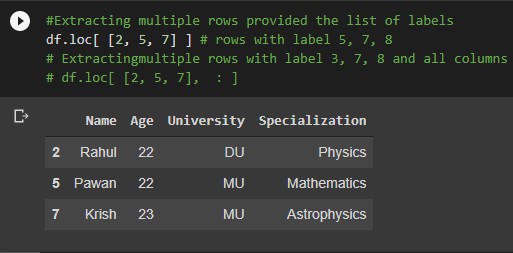
#Extracting the rows of a particular range of labels df.loc[ 2 : 8 ] # multiple rows using a range of labels df.loc[ 2 : 8 , ] # multiple rows using a range of labels and all columns df.loc[ 2 : 8 , : ]
Output:
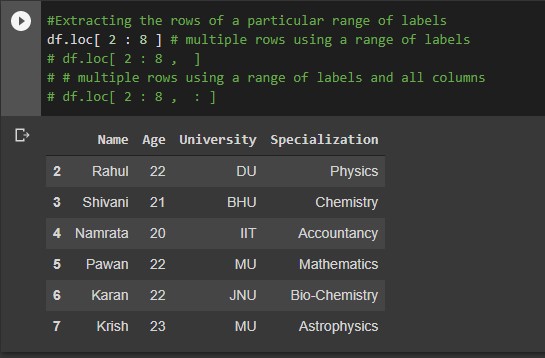
# Extracting multiple rows using labels and columns df.loc[ [1, 2] , 'col_1' : 'col_2']
Output:

Condition-based slicing:
Here we can extract specific columns or rows satisfying a particular condition.
#Extracting all the values in column whose value is greater than 22 df.loc[ df.Age> 22] df[ df.Age> 22]
Output:

#Extracting all the rows for which age in column are equal to 22
df.loc[ (df.Age== 22) , : ]
Output:
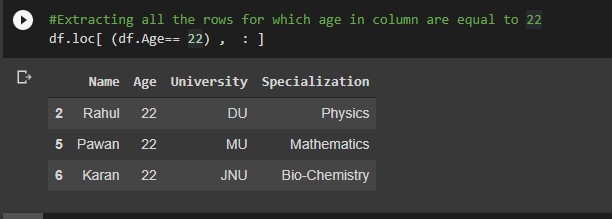
#Extracting all the rows for which age in column are not equal to 22
df.loc[(df.Age != 22), :]
Output:
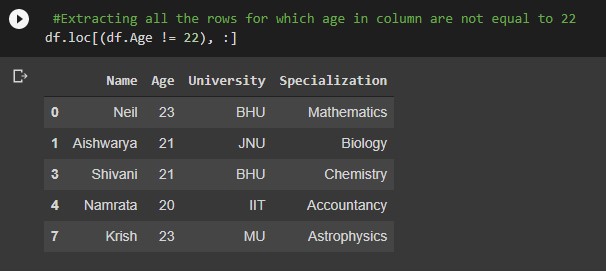
Multiple conditioning
#Extracting all rows where 21< Age< 23 and University = MU df.loc[ ( df.Age > 21) & ( df.Age < 23) & ( df.University == 'MU' ) , : ]
Output:

#Extract all rows where 22 > Age or University = 'MU' df.loc[(df.Age < 22) | (df.University = 'MU'), :]
Output:
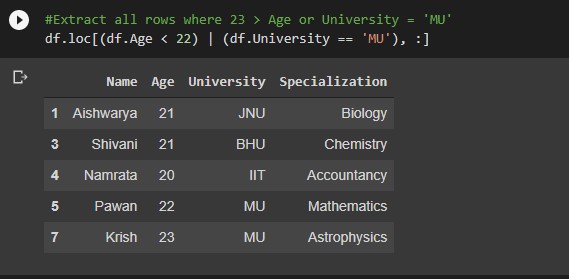
#Extracting the all the rows where column having the values in list df.loc[ df[ 'University' ].isin( ['MU', 'IIT' ) , : ]
Output:
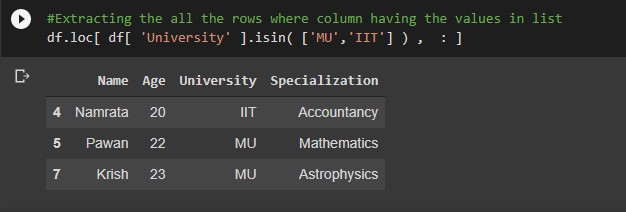
Output:

Various Operations:
- pd.merge :
This will merge the DataFrame or pandas Series objects with a database-style join.
Let’s take an example to understand this. First, we will create data frames and then join them with the inner intersection. There are more ways to join the data frames you can check that on official documentation.
data_1 = pd.DataFrame(
{
"key_1": ["K0", "K0", "K1", "K2"],
"key_2": ["K0", "K1", "K0", "K1"],
"A": ["A0", "A1", "A2", "A3"],
"B": ["B0", "B1", "B2", "B3"],
}
)
data_2 = pd.DataFrame(
{
"key_1": ["K0", "K1", "K1", "K2"],
"key_2": ["K0", "K0", "K0", "K0"],
"C": ["C0", "C1", "C2", "C3"],
"D": ["D0", "D1", "D2", "D3"],
}
)
#Merging the two dataframesby inner join on particular columns pd.merge( data_1, data_2, how = 'inner' , on = ['col_1', 'col_2' ] )
Output:

Concatenating pandas objects along the specified axis. you can get additional information from the link given above.
# concatenating dataframes one on top of the other pd.concat( [ data_1, data_2], axis = 0)
Output:

# concatenate two dataframes side by side
pd.concat( [ data_1, data_2] , axis = 1 )
Output:
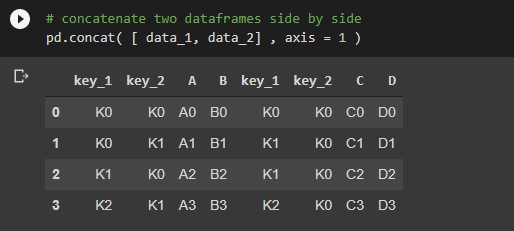
- Creating new columns
# adding a new column df['new_col'] = any_value
Output:
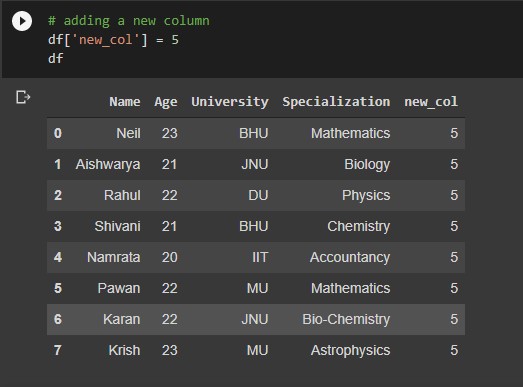
# add a new column by using existing columns df[ 'new_col' ] = df[ 'col_1' ] / df[ 'col_2' ]
Output:
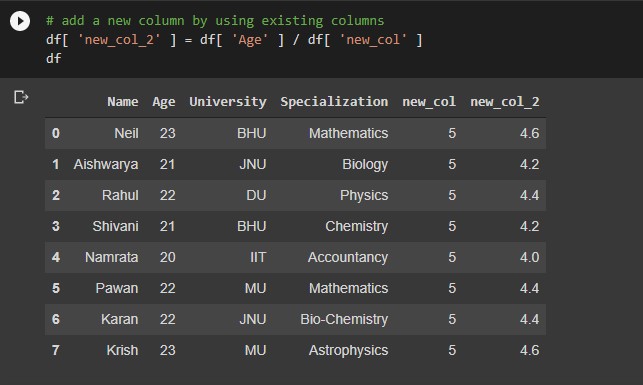
- Grouping the data
# grouping the data by specific columns df.groupby( [ 'col_1' , 'col_2' ] ) #Grouping the data by specific columns and aggregating df.groupby( [ 'col_1' , 'col_2' ] )['col_3'].sum() df.groupby( [ 'col_1' , 'col_2' ] )['col_3'].mean()
Output:
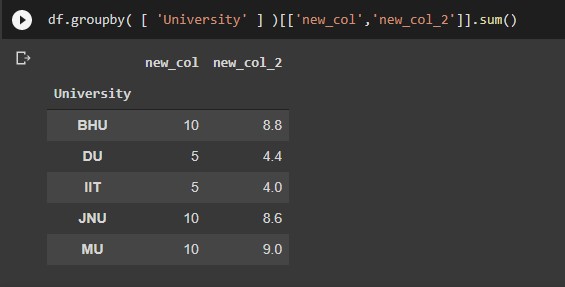
- Applying a function on a column that can be inbuilt also
df[ 'col_1' ].apply( lambda x: function(x) ) df[ 'col_1' ].apply( lambda x: np.log(x) ) #Invuilt function
Output:
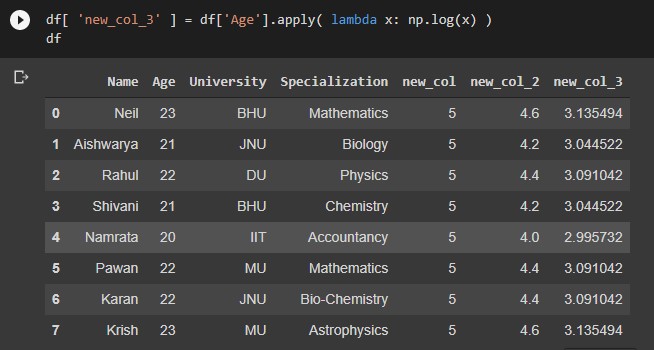
Pivot table:
Creating a spread-sheet like pivot table as a Dataframe
df.pivot_table( values = 'aggregation_col', index = 'group_by_row', columns = 'group_by_col', aggfunc = 'mean')
Output:
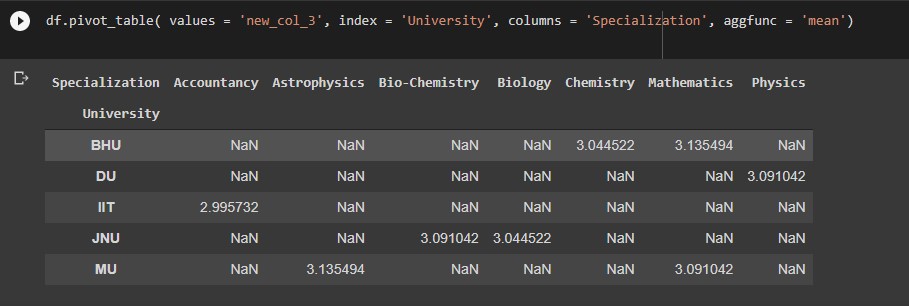
EndNotes
There are many more pandas operations that one can try or apply. I hope u enjoyed the article and got an idea of pandas.






